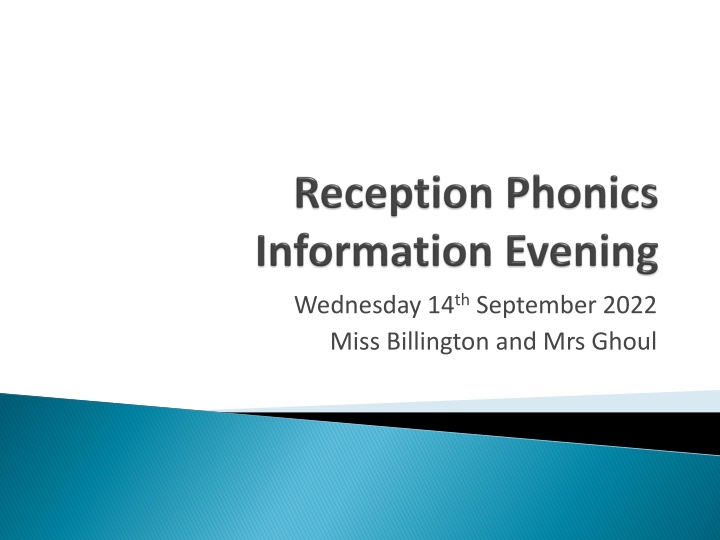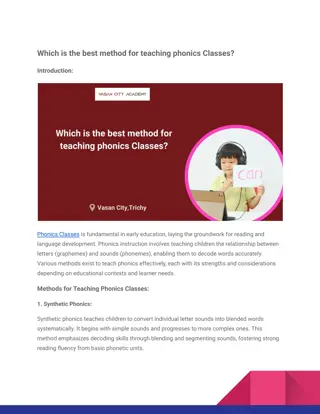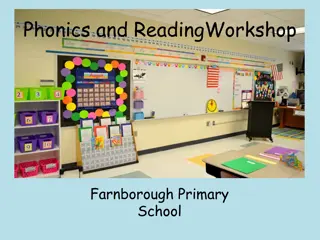Phonics Learning Program for Children
Explore a comprehensive phonics learning program for children featuring Miss Billington and Mrs. Ghoul. Discover the synthetic phonics approach with 44 sounds, digraphs, and more. Learn about teaching methods, including Fred Talk and Fred Fingers, to enhance reading and writing skills. Find guidance on helping your child at home and ensuring correct pronunciation. Dive into the world of phonics education for young learners!
Download Presentation

Please find below an Image/Link to download the presentation.
The content on the website is provided AS IS for your information and personal use only. It may not be sold, licensed, or shared on other websites without obtaining consent from the author.If you encounter any issues during the download, it is possible that the publisher has removed the file from their server.
You are allowed to download the files provided on this website for personal or commercial use, subject to the condition that they are used lawfully. All files are the property of their respective owners.
The content on the website is provided AS IS for your information and personal use only. It may not be sold, licensed, or shared on other websites without obtaining consent from the author.
E N D
Presentation Transcript
Wednesday 14thSeptember 2022 Miss Billington and Mrs Ghoul
How we will teach your child to read and write Phonics and the scheme we are using How to help at home! Image result for read write inc
Synthetic phonics There are 44 sounds in the English language Each sound is represented by a different letter/pair of letters (the grapheme ) Highly structured and repetitive daily 20-30 minute phonics lessons
digraph- 2 letters/1 sound (special friends) ch Image result for chips Image result for cat ca t i ps Image result for light bulb Image result for cake l igh t a e c k split digraph (best friends) trigraph - 3 letters/1 sound)
We are learning one sound per lesson, 3 lessons per week Each sound has a rhyme. Important to say the pure sound not uh at the end! For example h is hhhhh not huh. We do not teach letter names until the end of Reception. Do not be alarmed if your child writes with only lower case letters. We also introduce capital letters towards the end of Reception. Link to the correct pronunciation of phonemes on last slide .There are lots of videos @ Ruth Miskin Training on YouTube if you are interested!
Fred talk To read regular, phonetic words children need to say the sounds quickly In order to do this they need to be confident at linking sounds to letters and spot the digraphs/trigraphs/split digraphs They then need to hear the word that the sounds are making Longer words are chopped into syllables E.g. snowman s n ow m a n
Fred fingers Getting started: Fine motor skills, confidence in drawing and correct pencil grip For writing children need to say the word slowly and split it up into the sounds E.g. dog: d-o-g; farm: f-ar-m Writing is more difficult as children need to hear the sounds in the word and remember how each sound is written and the order of the sounds. Handwriting letter formation is very important!
This gets more difficult as some sounds have more than one grapheme Eg. Bike fly tie night and some graphemes have more than one sound Eg. Flower and grow
In order to read simple sentences the children will need to learn to read some of the most common but irregularly spelt words. As the children progress through the Read, Write, Inc programme they will learn the correct sound for the graphemes they come across when learning the red words. But to begin with we call them Red words . e.g. put I the she you said was We also sound out and read words that do not make any sense. e.g. gim soh dit Read, Write Inc. calls these Alien Words .
Children must be able to decode accurately and confidently before they can even begin to understand what they have read. Often we assume that children can answer comprehension questions if they can read it. We need to teach the skills for comprehension explicitly and from an early age to equip them to be successful readers.
RWI Book Bag Books- structured scheme of fiction books which will match the sounds your child has been learning at school. Children progress through the scheme, moving up the levels at their own pace. Not all words are phonetically decodable (Red Words) but phonics should be the primary strategy your child uses. It is important that children read regularly at home (as well as being read to daily). Let your child take the lead! Get them to teach you, be really encouraging and help them out it s not a test!
On the school website see class blogs each Friday Weekly Red word recognition Practise little and often! Letter formation practise Starting once the children have had a speed sound lesson for each letter of the alphabet Letter formation families Pincer grip is very important Support your child in saying the rhyme to aid correct formation it is very hard to unlearn the incorrect formation. Implications for joined-up writing Book Bag books Nearer to Christmas
The class blogs and the phonics page on our school website Free websites www.ictgames.com www.teachyourmonstertoread.com https://www.oxfordowl.co.uk/for-home/ (free e-books and tips) Subscription websites www.phonicsplay.co.uk More information about Read, Write Inc https://ruthmiskin.com/en/find-out-more/parents/ Please bear in mind that we will not have covered all of the phonemes on these resources. We will update you on our progress on the class blogs!
Practice makes perfect! Please don t put pressure on your child or yourself. School = High quality, rapid teaching and learning. Home = Consolidation and confidence. Home languages understanding and vocabulary in home language is a priority!
Sound pronunciation - Read Write Inc. How to teach blending to children - Phonics tutoring with Ruth Miskin























